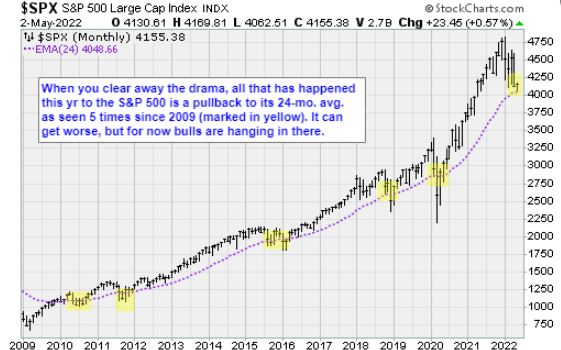Bulls began May the same way April ended, observes Jon Markman, editor of Strategic Advantage.
The S&P 500 (SPX) skidded 1.2% to its worst level in 2022 in the middle of the session as bond yields surged and volatility spiked. The yield for the 10-Year Treasury Bond (TNX) hit 3%, the highest level since 2018. The CBOE Volatility Index (VIX), a key measure of fear among traders, zoomed higher to 36, two full standard deviations above normal.
Predictably, everything changed in the late afternoon. Sellers became buyers. Short covering sent the benchmark S&P 500 to 4,155, a closing gain of 0.6%. Bulls should not get too excited, though. All of the heavy lifting on Monday happened in the bear camp. The S&P 500 slumped 10.9% during April, and it made good sense for bears to take some profits ahead of the Federal Reserve’s monetary policy announcement slated for Wednesday.

Short covering and some bargain-hunting on Tuesday should continue. There is now overhead resistance for the benchmark at 4,170, then 4,300. Critical support is 4,114 on a closing basis.
The Upshot
The Dow (DOW) finished up 0.3% to 33,061.50 and the Nasdaq (NDX) ended 1.6% higher to 12,536.02 after a super-volatile trading session. The Real Estate (XLRE) sector posted the steepest declines among sectors, while communication services were the top gainers. Breadth favored advancers four to three, and there were 44 new highs vs a whopping 1683 new lows. Big caps on the new high list were scarce as the honors were accorded to the obscure likes of Valero (VLO), Switch (SWCH), Lantheus (LNTH), and Sylvamo (SLVM).
The US ten-year yield surged 9.4 basis points to 2.98%. West Texas Intermediate Crude Oil Futures (CL=F) advanced $1.06 to $105.75 per barrel.
In economic news, the Institute for Supply Management's US manufacturing index fell to 55.4 in April from 57.1 in March, compared with expectations for an increase to 57.6 in a survey compiled by Bloomberg. "In April, progress slowed in solving labor shortage problems at all tiers of the supply chain," Timothy Fiore, chair of the ISM's manufacturing business survey committee, said. The reading is "still well in expansion territory, but momentum continues to slow," Jefferies economists Thomas Simons and Aneta Markowska said in a research note.
According to CME Group's Fed Watch Tool, the probability of a 50 basis-point interest rate increase to the 0.75% to 1% target range is almost 99% at a policy meeting on Wednesday. At the next month's meeting, the probability of the target range being increased further to 1.5% to 1.75% is 86%, implying most market participants continue to expect the Federal Reserve to lift interest rates at a brisk pace to control red-hot inflation. Meanwhile, March factory orders and job openings, scheduled for release Tuesday, will continue to give the Federal Reserve the ammunition to raise interest rates by at least 50 basis points on Wednesday with factory orders expected to increase by 1.2% and job openings (JOLTS) remaining near a record high.
In company news, Align Technology (ALGN) said it entered into an accelerated repurchase program to buy back $200 million of its common shares under its existing $1 billion buyback plan. Shares jumped 6.5%, the second-biggest gainer on the S&P 500 and the biggest on the Nasdaq 100.
Global Payments (GPN) reported better-than-expected earnings in the first quarter but expects full-year adjusted revenue to be at the low end of its forecast range amid pressure from currency rates and Russia. Shares of the payments-technology firm slumped 9.2%, the worst performer on the Nasdaq 100.




















